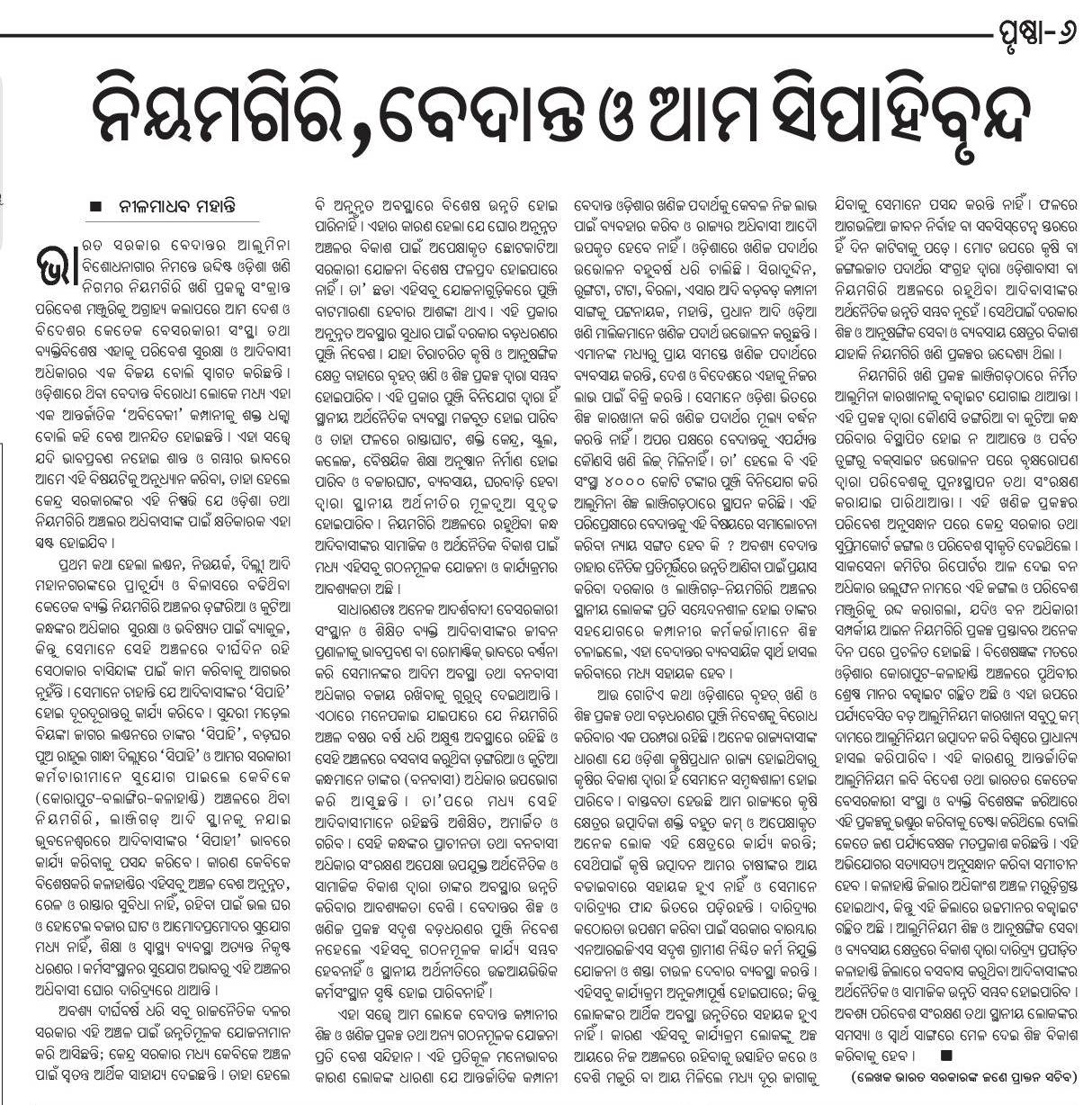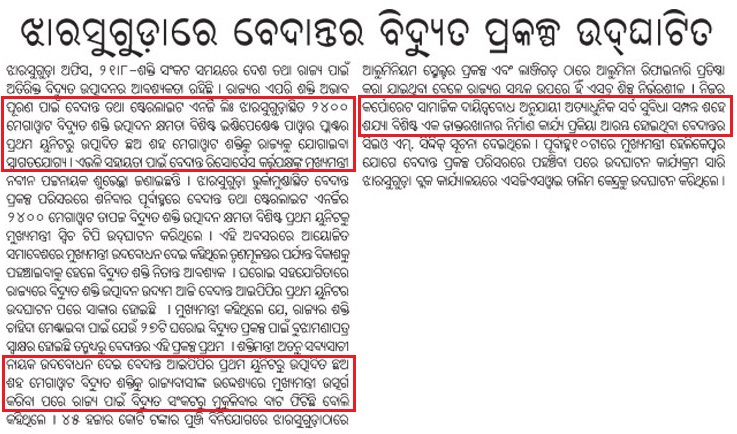Odisha’s growth will be steady; albeit slower than what some desire
EXPOSING ANTI-ODISHA-GROWTH SCHEMES, Odisha govt. action, Odisha govt. Inaction, POSCO, Universities: existing and upcoming, Vedanta 9 Comments »In the recently held by-elections in Umerkote in Nabarangpur district the BJD candidate won handily. The winning candidate from BJD had 54,713 votes while the candidate from BJP had 33,652 votes and from Congress had 32,877 votes.
In the 2009 elections the numbers were: BJD candidate – 44326, BJP candidate – 30,155, Congress candidate – 25,512.
Although this is just a single point data, but based on such data, my informal survey of people, my observations, and some other reasons I give below I predict the following:
- BJD will win the next assembly and parliament elections handily in Odisha and it may even have more parliament seats than it got in 2009.
I now give some reasons for my prediction.
- In the 2009 election BJD jettisoned BJP at the last moment; so it was not as prepared in some of the constituencies which had BJP representatives.
- For the same reason, during the 2009 elections, in many people’s mind BJD and BJP were aligned together, while Congress was the opposition. So with the vote split between BJD and BJP, Congress was able to sneak through in some places. Good examples of this situation are the Balasore and Sundergarh parliamentary constituents. In both places the BJP had strong candidates (in Kharabela Swain and Jual Oram, respectively) and thus the anti-Congress votes got split resulting in Congress wins in both places. The situation will be different in the next election. In the next election the anti-government votes will get split between Congress and BJP and both will do worse than they did in the 2009 elections.
Now let me list some of the attributes of the BJD party and its government and some points regarding the situation in Odisha.
- BJD’s supremo is a gentleman and closely guards his party members at all levels to follow some basic principles. There are aberrations, but he sorts them out expeditiously. Following is what I mean.
- The state ministers have very little authority or power. That way they don’t have much of an opportunity to engage in corruption; they can not do any corruption on behalf of the MLAs; the MLAs themselves or party workers at lower level can not indulge in any big corruption. So in general, there is no (or very little) visible corruption among BJD MLAs and ministers, especially towards personal gain. (Note: All parties in India get their party funds from various sources. There is some corruption involved in that.)
- The state functions via the bureaucrats and the important departments are headed by bureaucrats that have more or less spotless reputations. So the corruption by higher bureaucracy is not there.
- With a long running government BJD has a lot of party workers, but they are not like cadres of other parties. They are restrained from indulging in violence or similar activities that would antagonize the people. The BJD party and the Odisha government’s way of dealing with Kalinganagar and POSCO situation and its comparison with Singur is illuminating. In both Kalinganagar and POSCO, although the opposition parties have indulged in unlawful and sometimes violent methods, the BJD party has not countered with its cadres. The government has followed the strategy of wearing people out with time and leaving matters to law and order authorities but with strict instructions to be soft. Thus, even though some newspapers published by opposition parties have used the term "BJD goondas", the public does not have such a view of BJD having a goonda cadre.
- BJD has given SOPs to the poor people (2 Kg rice), have indulged in populist people pleasing policies (bicycle for girls), and has sincerely helped people during calamities. So its popularity among common people is growing.
- In essence, the government and the BJD party is not heavy handed and not arrogant and is perceived as people friendly. Ofcourse pockets of people are unhappy in places (e.g. Dhinikia) where promotion of industry clashes with people wanting to be left alone or people agitated by others; but by the government and its party not being heavy handed, arrogant or violent, such unhappyness is localized and as in Kalinganagar, it decreases with time.
- The *local* media–especially the top news papers–in Odisha keep a sharp eye on the government. They scrutinize every action and inaction of the government and are mostly critical of the government. They rarely praise any government initiatives. If one is not careful, one solely reading the local media may start having a distorted image of Odisha. But, although, I often feel bad by the negative portrayal of many things in the local media I realize that in the big picture view, this is good for Odisha. It keeps the government on its toes, keeps it in check, and prevents it from being arrogant. Once one takes the perspective that the job of the opposition and the local medial is to "oppose", "criticize" and "scrutinize" every government actions, and they are able to do that well and freely, then it is easier to get a better picture. Reading some comparative articles in the national media, such as this, also helps.
So how does BJD winning another term after this term reflect on Odisha’s future.
- It means that the current policies will continue and some of the big projects will happen. In particular, POSCO will go the Kalinagnagar way with the resistance slowly decreasing and development creeping in. Already a good chunk of the land has been acquired and basic efforts for construction (such as access roads) have started. The opposition can stop some of the land being acquired but they can not lawfully stop construction to happen in land that has already been acquired. They are trying, but I don’t see such unlawful efforts being sustainable. Similarly, if the Supreme Court gives ok to the Vedanta University land acquisition so far, then that will happen too. For both these big projects one can look back at Kalinganagar and Dhamara as models. In both Kalinagnagar and Dhamara, it took much longer than originally projected, but they happened. My prediction is same with respect to POSCO and Vedanta University.
- Although by various measures (of investment) Odisha is among the leading states in the country there is the perception that things move very slow here. The perception is true, but perhaps moving slow is necessary. Running roughshod over the people backfires in many ways. Again, Singur, West Bengal is a good example of that. Also, Chandrababu Naidu’s fast moving steps did not help him win the next election. So Odisha will move forward in a slow and steady manner slowly modifying some of the people’s anti-industry attitude and taking them along.
The above are broad stroke observations. There would be exceptions at individual levels. Similarly, the predictions are based on assuming that no abnormal events happen; the future is unpredictable and small events can change everything.
Now what can Odisha and BJD do better.
- Rope in good technocrats and have more people with decision making authority: I think BJD and Odisha would do better if BJD ropes in some good technocrats who have spotless reputations. There is so much one CM and a few trusted officers can do. The party needs to find a few more people within its ranks and increase its ranks with people it can trust (to be effective and not corrupt) and have more people with real decision making authority.
- Find ways to listen to local and regional voices: Currently, most in BJD are winning elections because of the party supremo’s image. Plus the tight control from above results in that they do not have much of a voice in government decisions. As a result they are not able to forcefully state regional aspirations and demands. This results in regional aspirations and demands being sidelined. For example, in this site we have highlighted many demands of Rourkela people. Because the local representatives (MLAs and one of them happen to be a minister) do not have much of a voice, for little things (like a new train) they have to hit the streets. This is not healthy and could ultimately result in BJD’s downfall and/or more vocal demands to split the state. If the MLAs and ministers can not be fully trusted and the trusted officers rule the roost in the government, may be a few more senior officers (besides the RDCs) can be each entrusted with a cluster of districts to look after. In particular, their job would be to bring to the higher level of the government demands and aspirations of people of those districts.



